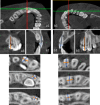Comparative evaluation of the volumetric and morphological characteristics of resorbed and non-resorbed maxillary lateral incisors associated with impacted canine
- PMID: 40604673
- PMCID: PMC12224588
- DOI: 10.1186/s12903-025-06383-7
Comparative evaluation of the volumetric and morphological characteristics of resorbed and non-resorbed maxillary lateral incisors associated with impacted canine
Abstract
Background: This study aimed to evaluate the morphological characteristics of resorbed and non-resorbed lateral incisors adjacent to unilateral palatally impacted maxillary canines intended to be positioned in the dental arch during orthodontic treatment. The volumetric and morphological differences between lateral incisors adjacent to impacted canines and those adjacent to erupted canines were examined.
Methods: The study group consisted of fifty participants with unilateral palatally impacted maxillary canines. The sample was divided into two groups: the resorbed group (RG) and the non-resorbed group (NRG), based on the resorption status of the lateral incisor adjacent to the maxillary impacted canine. Volumetric, dimensional, and angular differences were evaluated between these groups.
Results: No statistically significant difference was found between the RG and NRG groups in terms of lateral incisors. In both groups, there was a statistically significant decrease in lateral incisor volume, mesiodistal and buccolingual root width, and crown-root angle on the impacted side compared to the other side. In the RG group, the cervical, middle, and apical third volumes of the resorbed lateral root on the impacted side were statistically lower than on the other side.
Conclusions: In the RG and NRG groups, the volume and morphological features of the lateral incisors adjacent to the impacted canines were similar and smaller than those of the lateral incisors on the erupted side. In cases where it is desired to maintain the lateral incisors, whether slightly resorbed or not, in the dental arch, it is recommended that orthodontic treatment be optimized for stabilization.
Keywords: CBCT; Lateral incisor morphology; Maxillary impacted canine; Resorption.
© 2025. The Author(s).
Conflict of interest statement
Declarations. Ethics approval and consent to participate: Ethical approval was obtained from the Clinical Research Ethics Committee of Süleyman Demirel University, Isparta, Türkiye (2012- KAEK- 38.25.02.2021/ 132). All procedures involving human participants were in compliance with the ethical standards of the 1964 Helsinki Declaration and its subsequent revisions, or similar ethical norms. Informed consent was obtained from all participants. Consent for publication: Not applicable. Competing interests: The authors declare no competing interests.
Figures


Similar articles
-
To what extent are impacted canines associated with root resorption of the adjacent tooth?: A systematic review with meta-analysis.J Am Dent Assoc. 2018 Sep;149(9):765-777.e8. doi: 10.1016/j.adaj.2018.05.012. J Am Dent Assoc. 2018. PMID: 30165975
-
Three-dimensional dentoalveolar characteristics of a labially impacted dilacerated maxillary central incisor using cone-beam computed tomography.Sci Rep. 2025 Jul 9;15(1):24669. doi: 10.1038/s41598-025-10043-9. Sci Rep. 2025. PMID: 40634539 Free PMC article.
-
Assessment of the positional and morphological differences of unilaterally impacted canines: A cross-sectional study.J Stomatol Oral Maxillofac Surg. 2024 Sep;125(4S):101920. doi: 10.1016/j.jormas.2024.101920. Epub 2024 May 23. J Stomatol Oral Maxillofac Surg. 2024. PMID: 38795908
-
[Maxillary impacted canines: Statistical modeling of traction duration and resorption].Orthod Fr. 2025 Jul 16;96(2):203-215. doi: 10.1684/orthodfr.2025.187. Orthod Fr. 2025. PMID: 40668882 French.
-
Initial arch wires used in orthodontic treatment with fixed appliances.Cochrane Database Syst Rev. 2018 Jul 31;7(7):CD007859. doi: 10.1002/14651858.CD007859.pub4. Cochrane Database Syst Rev. 2018. Update in: Cochrane Database Syst Rev. 2024 Feb 06;2:CD007859. doi: 10.1002/14651858.CD007859.pub5. PMID: 30064155 Free PMC article. Updated.
References
-
- 2.Alemam AA, Abu Alhaija ES, Mortaja K, AlTawachi A. Incisor root resorption associated with palatally displaced maxillary canines: analysis and prediction using discriminant function analysis. Am J Orthod Dentofac Orthop. 2020;157(1):80–90. - PubMed
-
- 3.Ericson S, Kurol J. Incisor resorption caused by maxillary cuspids. A radiographic study. Angle Orthod. 1987;57(4):332–46. - PubMed
-
- 5.Murata N, Ioi H, Ouchi M, Takao T, Oida H, Aijima R, et al. E Ect of allergen sensitization on external root resorption. J Dent Res. 2013;92:641–47. - PubMed
Publication types
MeSH terms
LinkOut - more resources
Full Text Sources

